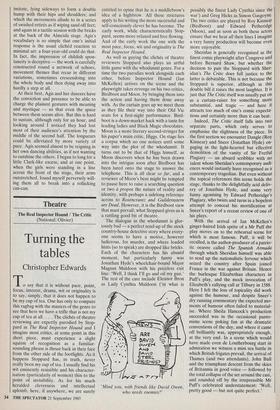Dance
Echo and Narcissus
Julie Kavanagh Can Michael Clark, tedeckt, ornate and gay' like Milton's Delila (clad at one point like a priapic, half-naked nanny) be taken seriously? And can his work be properly rated when it is burdened with a cacophonous accompaniment (hence the pun in the title of his new work, our caca phoney H — 'H' standing for the music from Hair); a limelight-hugging `singer'; a bevy of painted, pillowy nudists and mis- cellaneous hangers-on with vials of amyl nitrite up their nostrils? Most critics have already wagged pedagogic fingers at Clark, telling him to grow up and get on with the dancing. They have a point. But if this latest venture shows Clark at his most anarchic and extreme, it is also, choreo- graphically, his most substantial — and certainly his most classical — work to date. Richard Glasstone's six-week, Cecchetti- based tutelage of Clark and Company has extended and refined their range of move- ment, adding a new poise to their dancing that is a pleasure to watch.
As deliberately as he has stretched his dance resources, Clark has expanded the theatrical vein of his work by exploiting various aspects of showbiz for the first time. Before starting the piece, he told me he wanted to do something more adven- turous than musicals can afford to do, 'perhaps risking not getting the applause at the end. If it's really disastrous, we'll drop it.' Clark himself would probably admit that he went too far in this respect, but he is still at the stage of experimenting with various directions he could take; and at 23, is surely entitled to do so — even if it means making mistakes. He is a natural entertainer whose theatrical gift should not be crustily discouraged: just controlled.
By the end of his Riverside run, Clark had tightened up the show quite consider- ably, and in the first half especially was adeptly dovetailing the kitscherie with pure dance. There was still much one could do without, but there were also several in- delibly memorable instances which demon- strated how Clark's so-called silliness can be put to good effect. I'm thinking in particular of the splendid, classically inci- sive solo for Matthew Hawkins, which was somehow enhanced by his being dressed en travestie in an elegant 1930s teagown. Hawkins's striking Sitwellian profile and aristocratic bearing brought further wit and style to the dance.
Of Clark's attempts at contemporary satire, I liked the unexpectedly lyrical duet for two bovver-booted wimmin; and admired, to a degree, his interpretation of the current Sixties cult. For this — and as a general structural device — Clark uses music and images from Hair. The songs sweep the show along and allow him to work in a rhythmically complex way (he finds that classical music dictates too literal a response to the tempo), but all the same, there is something not entirely scrupulous about capitalising on someone else's suc- cess. Certainly much of my own enjoyment that evening derived from a private nostal- gia that had little to do with Clark.
By contrast, Gaby Agis's new pro- gramme is uncompromisingly personal and quite the opposite of Clark's in almost every other respect, even though she has been seen in the past as a kind of Echo figure to Clark's Narcissus. While he sets out to entertain, Agis demands empathy and effort on the part of the audience to attune themselves to what she is trying to do. Without this, her work is easy to dismiss as 'boring', as it does not conform to most people's conception of dance.
The key to the new piece is to be found in the interaction between dance and de- sign. The title, Undine and the Still seems hinted at in the watery splash of blue and the boulder-like shapes in Graca Coutinho's single painted panel, and is reflected in the easy fluidity of the choreography and its periods of stillness. The grainy texture of Coutinho's painting anticipates the 'set' for part two: a mam- miferous twin sand-dune which the dancers imitate, lying sideways to form a double hump with their hips and shoulders; and which the movements allude to in a series of swished retires as if wiping sand off feet; and again in a tactile session with the bricks at the back of the Almeida stage. Agis's vocabulary is so simple that one's initial response is the usual cliched reaction to minimal art: a four-year-old could do that. In fact, the impression of childish spon- taneity is deceptive — the work is carefully constructed round a network of echoes, movement themes that recur in different variations, sometimes crescendoing into the whole body and then dying away into hardly a step at all.
At their best, Agis and her dancers have the conviction and presence to be able to charge the plainest gestures with meaning and mystique — so that even the space between them seems alive. But this is hard to sustain, although only for an hour, and looking around I noticed they had lost most of their audience's attention by the middle of the second half. The longueurs could be alleviated by more variety of pace. Agis seemed almost to be reigning in her own dancing abilities, as if not wanting to outshine the others. I began to long for a little Clark-like excess; and at one point, when the girls were standing in a line across the front of the stage, their arms outstretched, found myself perversely will- ing them all to break into a rollicking can-can.















































 Previous page
Previous page